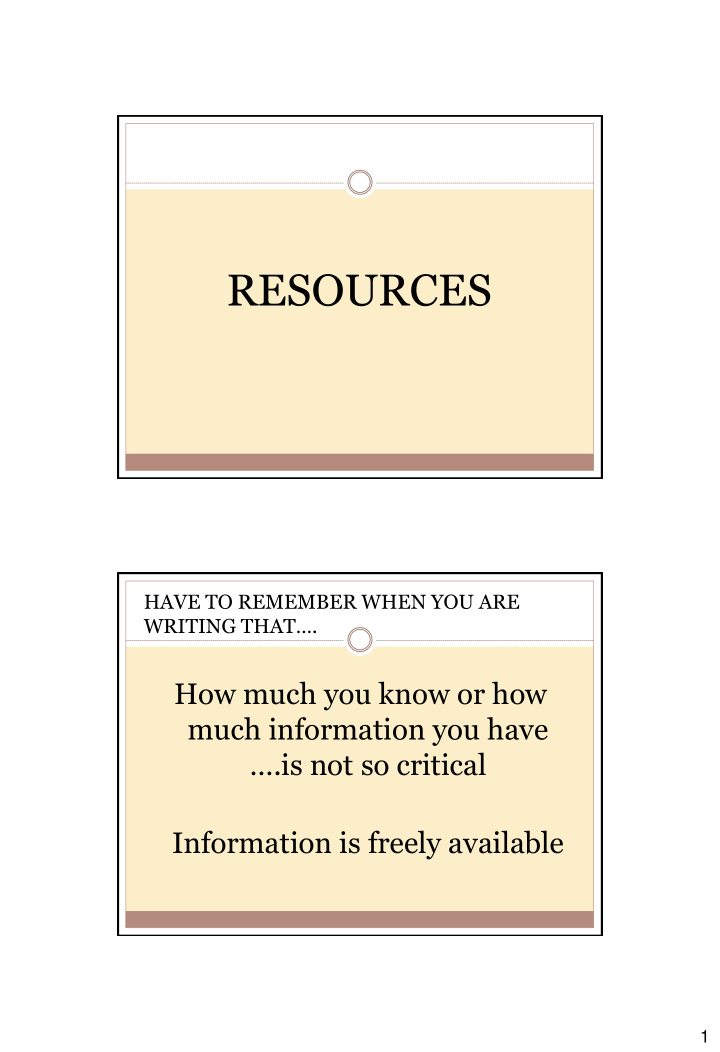



RESOURCES HAVE TO REMEMBER WHEN YOU ARE WRITING THAT…. How much you know or how much information you have ….is not so critical Information is freely available 1
What is important…. Is how you get your information What information you are using Is it reliable, authoritative, evidence- based, practice-based? Clearly relevant to task Is enough information but not much? RESOURCES – Which ones to use? • Journal articles • Books • Web sites (Intute) • Policy papers and National Guidelines • Legislation • Personal experience • TV/RADIO • Newspapers and magazines "Quality is in the eye of the beholder" - you need to take a case-by-case approach to evaluating information. Be clear about purpose. 2
How you use information is crucial Interpretation, integration, discussion, critical analysis - of information and practice Explain and demonstrate your understanding of research/theories/ideas Summarise, compare and contrast ideas, research, practice Consider different aspects and perspectives Question, analyse and integrate ideas, research, practice Relate research/policy information to your practice how does information relate to, and inform, practice Conclude - create ‘new’ knowledge or information o how does information impact on future actions/thinking/practice Bringing information together to create …. ...a final piece of coherent text…Important part of this is referencing PLAGIARISM What it is & how to avoid it! 3
What exactly is plagiarism? The University of Stirling has a definition for plagiarism…… ‘ To plagiarise is to represent as one’s own the intellectual property of another’. University of Stirling (2009) Plagiarism in Postgraduate Coursework and Dissertation Web Site. Available from: http://www.quality.stir.ac.uk/ac-policy/PlagiarismPG.php (Accessed July 20 th 2009) So plagiarism is…..? Copying, reproducing or replicating somebody else’s work, directly or indirectly, without acknowledging where the work came from. Schoeffer, which he (Bergel) had heard confirmed in conversations…. https://www.google.co.uk/search?q=image+of+dense+text&hl=en&tbm=isch&img il=01NWtD2Wpg8ffM%253A%253BoOHaTbbKCfHElM%253Bhttp%25253A%25 252F%25252Ftypophile.com%25252Fnode%25252F16376&source=iu&usg=__t yUw0NqJ5Zu_I- 4tW5cPr_k3K74%3D&sa=X&ei=WBj7U_exI4bhat2VgcAK&ved=0CCMQ9QEwA A&biw=1280&bih=871#facrc=_&imgdii=_&imgrc=01NWtD2Wpg8ffM%253A%3B oOHaTbbKCfHElM%3Bhttp%253A%252F%252Ftypophile.com%252Ffiles%252 Ftypo_1911_britannica_snippet.jpg%3Bhttp%253A%252F%252Ftypophile.com %252Fnode%252F16376%3B500%3B321 4
Penalties Plagiarism is a viewed as a form of cheating. It is taken very seriously. Plagiarism Policy available on http://www.quality.stir.ac.uk/ac-policy/assessment.php It is your responsibility to read and understand it. How to avoid plagiarism Image available from http://www.hipernetix.com/rainbow/images/correct_tick.jpg (Accessed July 20th 2009) 5
HARVARD SYSTEM When you quote the exact words (i.e. copy) from somebody else’s work, you must include: quotation marks the author/s’ name/s date of publication the page number of the quotation a full reference to the source of information, listed at the back of your assignment (a reference list) Essay example Husman (1999, 113) suggested that there are ‘two divisions of student motivation: intrinsic-extrinsic motivation and future- present orientation.’ In reference list Husman, J. (1999) The role of the future in student motivation. Educational Psychologist , 34 (2), pp. 113-125. HARVARD SYSTEM You can use somebody else’s ideas or words and re-write (paraphrase) them into your own words. However, you must still acknowledge the work by including: the author/s name/s the date of publication a full reference to the source of information in the reference list at back of assignment Essay example Motivation is one factor that may encourage students to participate in learning. Research (e.g. Husman 1999) has indicated that it could be useful to classify motivation into two distinct categories. The first division (intrinsic-extrinsic motivation) is based upon internal and external influences. The second division (future-present orientation) is focused more on chronology (time). Reference list Husman, J. (1999) The role of the future in student motivation. Educational Psychologist , 34 (2), pp. 113-125. 6
REFERENCE LISTS Every source acknowledged within your essay has to also be included in a reference list at the back of your assignment. This should include all the information on your sources so that the reader can find the original work. Reference style = HARVARD STIRLING UNIVERSITY Collect all the reference information as you go along to save looking for it all at the end OR use software to organise your references. EXERCISE The paragraph you are given has been taken from Pharmacology (4 th edition, 1999) by Rang, Dale and Ritter (1999). The extracts in the table have been written by students using the information from the journal article. Decide whether or not you think the extracts could be considered to be plagiarised. (Image from: http://www.yangtown.com/images/post_written_exercise.jpg Accessed 20th July 2009) 7
This is the text as it is written in the journal article . During the last 60 years the development of effective and safe drugs to deal with bacterial infections has revolutionised medical treatment, and the morbidity and mortality from microbial disease have been dramatically reduced. http://ngm.nationalgeographic.com/2013/01/125-microbes/oeggerli-photography#/05-intestinal- bacteria-670.jpg 8
Recommend
More recommend